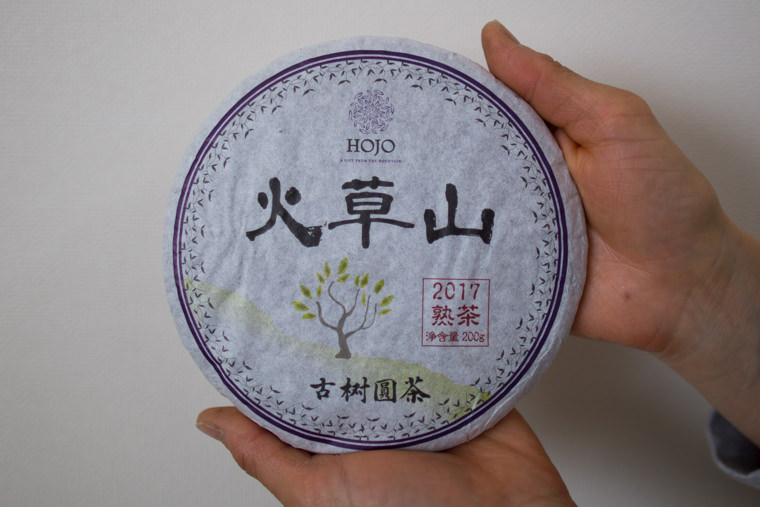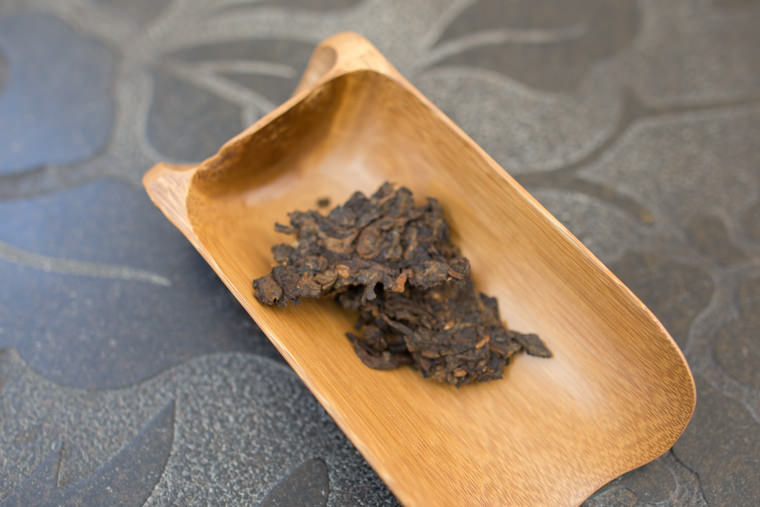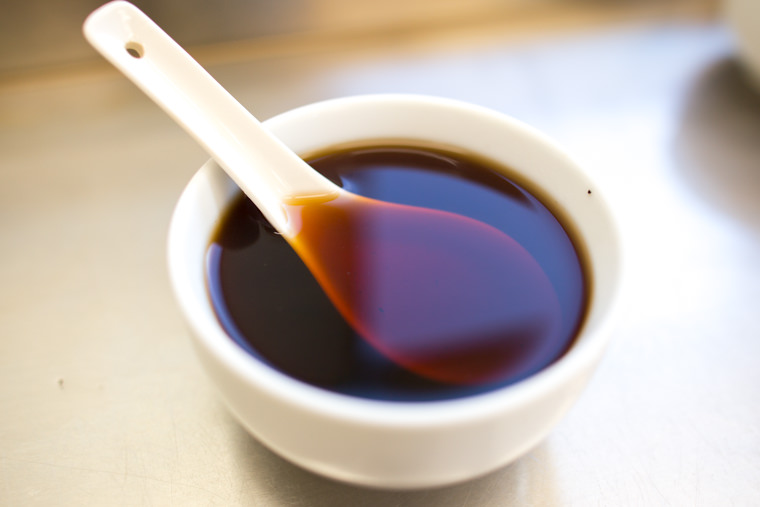- HOME >
- New Arrival at HOJO Online Shop
New release of Huo Cao Shan Ripe Pu-erh Tea 2017
- [2018.05.27] Posted By Akira Hojo
Using the spring tea collected from the garden that is left in wild for more than 30 years, we made Huo Cao Shan ripe pu-erh tea. It gives soft and silky mouth-feel with long-lasting aftertaste, with a hint of sweet flavour like dates or dried figs.
Huo Cao Shan is located near the Myanmar border
Huo Cao Shan is located in the south west of Lincang. It is situated in Zhenkang county facing to the national border of Myanmar. Next to Huo Cao Shan is Ma An Shan, one of the renowned mountain that produces excellent tea. The process of making this tea is not unique, but the material is very special. Because of Huo Cao Shan is located at far distance from the nearest airport (more than 8 hours), we found that a number of tea gardens are still kept in very traditional way. The tea gardens are left in wild, with no fertilizer, no pesticide or herbicide and most of the time, weeds are remained. The tea trees are surrounded with wild plants and it’s a well-balanced ecology.
It looks like bush. But actually, it is the tea garden that is left in wild.
Ripe pu-erh tea made of spring crop is very limited
The main market of ripe pu-erh tea is north-east of China or overseas. These are quite price sensitive market. Thus, most of the ripe pu-erh tea manufacturers are very particular about the cost of raw material. Normally, some manufacturers will blend three seasons tea in order to even out the cost and the quality. In most cases, the manufacturers only use two seasons tea (summer and autumn) for making ripe pu-erh tea. In the past two years, more and more manufacturers use only summer and autumn crop for making ripe pu-erh as the price of spring crop has increased a lot. Nowadays if we purchase tea from wholesalers in Kunming or Guangzhou, we can hardly get the ripe pu-erh tea made of 100% spring tea.
Nevertheless, if one has ever tasted spring tea, it is hard to come back to the summer or autumn tea. The taste and the flavour are obviously different. The spring tea taste is soft, mellow, rich, sweet and the after taste lasts for a long time.
The freshly produced raw pu-erh of Huo Cao Shan.
Custom-order ripe pu-erh tea
The ripe pu-erh tea is produced through the fermentation of raw pu-erh tea. The raw material of Huo Cao Shan ripe pu-erh tea gives an excellent drinking sensation even if we drink it before fermentation. It is essential to choose the quality material in order to produce quality ripe pu-erh tea. However, the fermentation of ripe pu-erh tea required several tonnes of raw pu-erh tea to be piled at one time, and the whole fermentation process takes about 45-60 days. It involved huge cost and high risk. We have been requesting our manufacturer to produce premium ripe pu-erh tea. But it was not very easy to convince them, especially recently the price of raw pu-erh has skyrocketed. Usually, the commercial tea markets are expecting low price ripe pu-erh tea and less demand for the high-end ripe pu-erh tea. Our manufacturer knew that it would not be easy for him to sell premium ripe pu-erh tea. However, after many rounds of discussion and persistent request, finally our manufacturer found the way to conduct fermentation in much smaller scale, and he managed to collect the raw pu-erh tea from Huo Cao Shan for making ripe pu-erh tea.
Appropriate material and process makes it excellent flavour
A number of customers told us that the reason they did not like ripe pu-erh tea is because of the particular smell that reminded them of old furniture or mold. In fact, this specific flavour is composed because of two reasons. Firstly, if moisture is too high and aeration is not sufficient during the fermentation, it promotes the growth of anaerobic bacteria. It produces musty or earthy smell. During piling process, tea has to be agitated regularly in order to supply adequate oxygen. Once the moisture and oxygen supply are adequate, the aerobic bacteria dominate the fermentation and increase the temperature of tea leaves. As a result, it supresses the growth of other unfavourable bacteria and eventually it produces sweet fruity flavour.
Another reason of the formation of unpleasant flavour is due to the raw material. As manufacturers are too particular about the cost, they often collect the low cost raw pu-erh tea directly from farmers at remote villages; these raw pu-erh teas often have extremely smoky flavour. After the fermentation, the smoky smell still remains as typical smoky and woodsy flavour of ripe pu-erh tea. Some people likes it but some people do not like it.
Huo Cao Shan ripe pu-erh tea gives very mellow drinking sensation with sweet Chinese dates flavour. As this tea is very rich in mineral, it will age well. I particularly recommend this tea for the customer who usually love raw pu-erh tea. This should be the tea that even raw pu-erh tea drinker could also enjoy.
Related Articles
How to get the latest update on HOJO Tea?
1. Follow Twitter, 2. Click "Like" on Facebook, and 3. Subscribe in newsletter. You can have the latest tea news from HOJO Tea.
 Subscribe the Newsletter to enjoy the privileges
Subscribe the Newsletter to enjoy the privileges- You may receive a free sample upon purchase, or you may have the priority to purchase special products. So please remember to subscribe our newsletter as well as the social network.
- New Release of High Mountain White Tea
- We are pleased to introduce our High Mountain White Tea, sourced from a unique tea garden with two key features: 1. Located at an altitude of 2200-2300m2. Completely wild and untended The ideal natural conditions of this garden result in tea of exceptional quality, offering a pure and gentle, nourishing taste. High Altitude and Wild …
- New Release of Da Xue Shan Wild White Tea 2024
- We have released the 2024 Da Xue Shan Wild White Tea Loose Leaf. This tea was produced under our direct supervision during our stay in Yunnan Province, ensuring meticulous production management on site. Definition of Wild Tea in Yunnan Province People in Yunnan strongly associate Camellia taliensis with wild tea, regardless of where it is …
NEW ARTICLES
 Why Do Some Teas Taste Astringent? Exploring the Causes and Mechanisms of Astringency
Why Do Some Teas Taste Astringent? Exploring the Causes and Mechanisms of Astringency- Tea can range from having no noticeable astringency to possessing a very strong one. What causes this astringency? This article explores the causes and mechanisms behind astringency in tea. Causes of Astringency Astringency arises from the binding of tea components to proteins in the oral cavity, creating a sensation of tightness or dryness. The tongue …
 The Impact of Heat Sources on Tea Flavor
The Impact of Heat Sources on Tea Flavor- It is widely recognized that the material of a kettle plays an important role in shaping the taste of water for brewing tea. Yet, an often overlooked but equally significant factor is the type of heat source used to boil the water. Different heat sources, whether gas, electric, charcoal, or wood fire, can impart distinct …
 New Release of High Mountain White Tea
New Release of High Mountain White Tea- We are pleased to introduce our High Mountain White Tea, sourced from a unique tea garden with two key features: 1. Located at an altitude of 2200-2300m2. Completely wild and untended The ideal natural conditions of this garden result in tea of exceptional quality, offering a pure and gentle, nourishing taste. High Altitude and Wild …
 New Release of Da Xue Shan Wild White Tea 2024
New Release of Da Xue Shan Wild White Tea 2024- We have released the 2024 Da Xue Shan Wild White Tea Loose Leaf. This tea was produced under our direct supervision during our stay in Yunnan Province, ensuring meticulous production management on site. Definition of Wild Tea in Yunnan Province People in Yunnan strongly associate Camellia taliensis with wild tea, regardless of where it is …
 New Release of Wild Pu-erh Jasmine Pearl
New Release of Wild Pu-erh Jasmine Pearl- Out of curiosity, we decided to create a jasmine tea based on Da Xue Shan Wild Raw Tea. This resulted in an exceptionally rare tea, not only in Japan but also in China. Custom Production Network for Jasmine Tea At our store, we source various types of base teas from different regions during the spring. …
 2024 Overview: Our Yunnan White Tea Quality, Process, and Weather Insights
2024 Overview: Our Yunnan White Tea Quality, Process, and Weather Insights- One of the teas we’ve been focusing on in Yunnan Province is white tea. Historically white tea has been produced in both Fujian Province and Yunnan Province for a long time. While white tea from Fujian Province is well-managed during processing, we are dissatisfied with the quality of the raw materials due to the use …
 Yunnan’s Hospitality Culture: Expressed Through Meals
Yunnan’s Hospitality Culture: Expressed Through Meals- In China, as a form of greeting, it’s common to say “你吃饭了吗?” which means “Have you eaten?” However, in Yunnan Province, the phrase “吃饭” is often used in various situations, more like “Eat, eat,” serving as an invitation to share a meal. Yet, with prolonged exposure to Yunnan, one comes to understand that these meal …
 In Search of Wild Tea: Exploring Mountain Villages in Southwest Lincang, Yunnan
In Search of Wild Tea: Exploring Mountain Villages in Southwest Lincang, Yunnan- We are currently sourcing tea in the southwestern part of Lincang City, Yunnan Province. One of the crucial products for us is wild tea. While tea processing is important, securing the raw materials poses the biggest challenge. Recently, we received information about a new location where wild tea supposedly grows. To verify this, we visited …
 New Release of Anxi Traditional Oolong
New Release of Anxi Traditional Oolong- Anxi, located in Fujian province, China, is celebrated for its Tie Guan Yin tea. However, the Traditional Anxi Oolong from this region boasts a unique fruity aroma, distinguishing it from Tie Guan Yin. Anxi: A Renowned Hub for Oolong Tea Production in China Fujian Province, renowned for its rich tea heritage, boasts several prominent tea-producing …
 Yunnan 2024 Spring Tea Sourcing
Yunnan 2024 Spring Tea Sourcing- Yunnan Province is globally renowned for the exceptional quality of its tea leaves. However, lax production management often presents challenges in achieving the desired tea quality when relying solely on pre-made teas. To address this issue, we have committed to remaining on-site throughout the spring season to closely monitor tea production. We are meticulously inspecting …
Shop Info

Address:Lot No. T-215, 3rd Floor, The Gardens Mall, Mid Valley City, Lingkaran Syed Putra, 59200 Kuala Lumpur
Tel: +603-2287-4537
Business Hour: 10am to 10pm
Category
- New Arrival at HOJO Online Shop
- Featured Articles
- Newsletter
- Types of Tea
- Origin of Tea
- Teapot and Tea Equipment
- Tea Column
- How to enjoy tea
- Tea Processing
- How to choose quality tea
- Tea constituents and functional effect
- Safety of Tea
- Foods
- Tea Business Operation
- Hobby and Outdoor Activity
- Ranking of Tea
- Video
- FAQ
- Media Release
Profile

- AKIRA HOJO
- I invite you to experience my tea selections.I was born in Nagano, Japan. In university, I studied agricultural chemistry, and I have the master degree in food science. I worked in Japanese food industry for 10 years. I involved in R&D, QC and QA. As a factory manager, I implemented ISO9000 series and managed the factory.
- The Art of Tea Magazine
- We posted the article on “The Art of Tea Magazine No.9, the magazine is published in Taiwan. We featured some scientific view about the tetsubin
- New Straits Times
- The Malaysian National Newspaper, New Straits Times featured HOJO Tea on 17-Oct-2007.






















